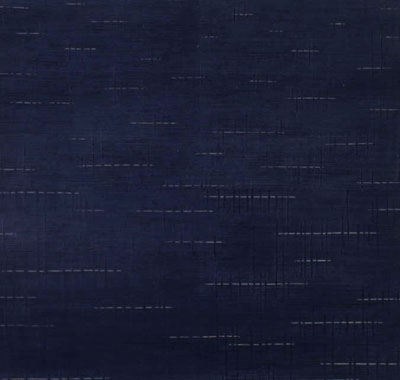 Rebecca Salter: CC15, 2002 acrylic on paper 38 x 41cm Rebecca Salter Kris Fierens Works on Paper Rebecca Salter's paintings are quiet, and calm, and perhaps subliminal. They are spare, where everything has been reduced to its essentials and where every mark, colour, tone, break or variation, counts - and the fewer there are the better. She wants silence, or at the very least whispers. Her working process is labour intensive. The paintings are worked layer upon layer, over and over, and are taken slowly and deliberately from the pronounced and explicit to a finely striated delicate mesh-like surface, made by adding and adding and removing and adding veils of pigment which masks or quietens previous marks and workings, but never obliterates or covers, until they reach a point of emptiness and quiet, and resonance. Salter spent years living and studying and working in Japan, and her paintings are informed by her own interpretation of the materials and processes innate in Japanese art and culture. Rebecca Salter shows regularly in the UK, the US, Germany and Japan and is represented in collections throughout the world including; The Tate Gallery, The British Museum, San Francisco Museum of Modern Art, JP Morgan, New York and The Heithoff Family Collection, California. Salter's 2002 solo show at Hirschl Contemporary Art coincided with a book cataloguing her new work. Kris Fierens' recent work is essentially about the beauty of chaos. His starting point is not an image, an idea, an object or a concept, but a gesture; or a movement that leaves a mark that is a never to be repeated combination of the unique, the gestural, the subconscious and the emotional. Marc Ruytens likens it to the patterns formed by a flock of starlings in flight, which, he says, computer analysis has proved are unique and never repeated. Fierens work never redoes itself, but the one constant in it is this element of chaos or accident. Recently, the majority of the work has been made using watercolour on paper, a medium usually associated with "Sunday" painters, but Fierens is not a typical watercolour artist. He uses paint and pigment and a lot of water on very large sheets of hard, smooth paper, and the time it takes for each painting to dry is an important part of his overall process - as intrinsic to the quality of the finished work as the act of applying the paint itself. During this period, the pigment dries to a thin veil, leaving a trace, or a memory, of the original mark put down. Fierens works continually, and makes any number of "tryouts" from which he selects a successful piece, but is alert to the dangers of painting "effects", and inevitably ends up with a huge pile of discards. It is as if each of the selected pieces are found fragments of his overall process. He concentrates on the gesture, and wants each spreading mark to leave what he calls a weak impression - or a stain - making the work fleeting and elusive. The process is automatic, but for him, the improvisational quality of the work is never meant to be an opening up of his subconscious. The gesture itself is the motif, but he is not ordinarily interested in the painterly gesture. 12 March - 12 April, 2003 Hours: Mon-Fri 10 am - 6 pm, Sat 11 am - 4 pm Hirschl Contemporary Art 5 Cork Street GB-London W1S 3LQ Telefon +44 (0)20 7495 2565 Mail hirschl@dircon.co.uk www.hirschlcontemporary.co.uk |